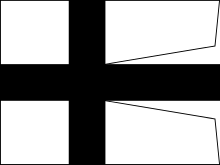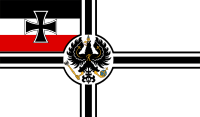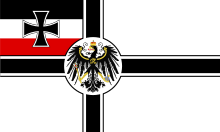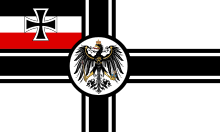Reichskriegsflagge

Reichskriegsflagge (German: [ˈʁaɪçsˌkʁiːksflaɡə], Imperial War Flag) was the official name of the war flag and war ensign used by the German armed forces from 1867 to 1945. A total of seven different designs were used during this period.
German Empire 1848/1849
The first German imperial war flag was introduced by imperial law on 12 November 1848. The Regent signed it that day, although the National Assembly had already voted for it on 31 July. The law described the commercial and war flag of the emerging new German federal state. The 'German colours' black, red and gold were so popular that it did not seem necessary to mention them in the constitution of 1849.[1] The flag was used for the Imperial Fleet, also during the short battle near Heligoland, on 4 June 1849. This was the first and only maritime battle in which these colours were involved.
The Federal Diet had already adopted the German colours on 9 March 1848, but the Diet and also the Central Power forgot to announce the new flag to the foreign powers. By May 1850, the flag was recognized by the USA, the Netherlands, Belgium, Sardinia, Turkey, Portugal, Naples, Spain, Greece and (conditionally) France.[2] The reestablished German Confederation took over the fleet, but sold it in 1852 and did not make use of the German colours again until the 1860s.
North German Confederation


After Prussia defeated Austria in 1866, the North German Confederation was founded by Prussia in order to replace the former German Confederation in which Austria had been the dominant power. The new Confederation eventually became the German Empire after the Franco-Prussian War, hence the Imperial German flags date back to the North German Confederation.
Because Prussia had emerged as the leading German state and the black-red-golden colour scheme was, at that time, associated with pan-Germanism (a Germany including Austria) and the revolution of 1848, the Prussian King and President of the North German Confederation, Wilhelm I, insisted on using new flags inspired by Prussia and without the traditional German colours. Therefore, the North German and eventually Imperial German flags prominently featured the Prussian colours (black and white) as well as symbols like the Prussian eagle and the Iron Cross. And while seafaring was the traditional domain of the Hanse in Germany, virtually all of the 19th century German coastline (including the North Sea coast) and naval power belonged to Prussia after the decisive victory in 1866.
Prince Adalbert of Prussia, the commander-in-chief of the North German Navy, was commissioned with finding the design of the new war ensign. Around 1850, he already had designed a number of potential war ensigns for a hypothetical German nation-state under Prussian rule, which never were adopted as the project was not realized at that time. He used his old ideas to design the new North German war ensign with heavy involvement of the Prussian King, leading to numerous changes, like the inclusion of the Iron Cross in its original shape.[3]
The flag that was finally adopted became the war ensign of the German Empire after its founding, similar to the North German merchant ensign.
 One of Prince Adalbert's early proposals for a German war ensign.
One of Prince Adalbert's early proposals for a German war ensign. One of Prince Adalbert's early proposals for a German war ensign.
One of Prince Adalbert's early proposals for a German war ensign. One of Prince Adalbert's early proposals for a German war ensign.
One of Prince Adalbert's early proposals for a German war ensign. One of Prince Adalbert's early proposals for a German war ensign, 1849.
One of Prince Adalbert's early proposals for a German war ensign, 1849. 1867 proposal for a North German war ensign.
1867 proposal for a North German war ensign. The final design for the North German war ensign (1867).
The final design for the North German war ensign (1867).
Imperial Germany
.jpg)

The German war flag, which was slightly changed two times during the Wilhelmine Period (see gallery below), was in common use in World War I. It continued to have Prussia's national colours of black and white, the eagle of Prussia, the Nordic cross, with the German imperial black-white red tricolour in the upper canton with an Iron Cross. In 1919, the flags of Imperial Germany were scrapped and replaced by those of the Weimar Republic: black-red-gold tricolour.
German nationalists, such as the Freikorps (see Marinebrigade Ehrhardt) and later the Nazis, used the old flag in protest against the Weimar Republic during the 1920s and 1930s. This included the 1920 attempt to overthrow the Weimar government, known as the Kapp Putsch.[5]
Use during the Third Reich, 1933–45

Designed personally by Adolf Hitler, this flag served the Heer and the Luftwaffe as their War Flag, and the Kriegsmarine as its War Ensign (the National Flag serving as Jack). This flag was hoisted daily in barracks operated by units of the Wehrmacht combined German military forces, and it had to be flown from a pole positioned near the barracks entrance, or failing this, near the guard room or staff building. New recruits in the latter part of World War II were sworn in on this flag (one recruit holding the flag and taking the oath on behalf of the entire recruit class with the recruits looking on as witnesses - before, this was done on the regimental colors).

The flag had to be formally hoisted every morning and lowered every evening. These hoisting and lowering ceremonies took the form of either an ordinary or a ceremonial flag parade. At the ordinary raising, the party consisted of the Orderly Officer of the Day, the guard, and one musician. At the ceremonial raising, one officer, one platoon of soldiers with rifles, the guard, the regimental band, and the corps of drums were all present.
The proportions of the flag are 3:5. Fusing elements of the Nazi German Flag (swastika and red background) with that of the old Imperial Reich War Flag (four arms emanating from off-center circle and Iron Cross in the canton), these flags were uniformly produced as a printed design on bunting.
Raised for the first time at the Bendlerstraße Building (Wehrmacht Headquarters) in Berlin on November 7, 1935, It was taken down for the last time by British occupation forces after the arrest of the Dönitz Government at the Naval Academy Mürwik in Flensburg-Mürwik, Germany, on May 23, 1945.
In his book, Inside the Third Reich, Albert Speer states that "in only two other designs did he (Adolf Hitler) execute the same care as he did his Obersalzberg house: that of the Reich War Flag and his own standard of Chief of State."
Use after 1945

Outside of educational, artistic or scientific contexts, selling and showing symbols of Nazi Germany, including the Reichskriegsflagge, is illegal in Germany according to Strafgesetzbuch section 86a. This covers the version used after 1935 with the swastika.
The original flag used between 1871 and 1919 can be shown depending on circumstances in different states of Germany. Because members of the far right have used the imperial war flag as a symbol, its use is considered to be a "breach of the public order" in seven states, and flags will be confiscated. In the other nine states, any provocative misuse of the flag can be prosecuted as an Ordnungswidrigkeit (summary offence).
Kriegsflagge
.svg.png) War flag of the Imperial Fleet of 1848-1852
War flag of the Imperial Fleet of 1848-1852 North German Federal Navy 1867–71 and Kaiserliche Marine War Ensign 1871–92 (Reichskriegsflagge)
North German Federal Navy 1867–71 and Kaiserliche Marine War Ensign 1871–92 (Reichskriegsflagge) Kaiserliche Marine War Ensign 1892–1903
Kaiserliche Marine War Ensign 1892–1903 Kaiserliche Marine War Ensign 1903–19
Kaiserliche Marine War Ensign 1903–19.svg.png) 1919–21 War ensign (de facto never used)
1919–21 War ensign (de facto never used).svg.png) 1921–33 War ensign
1921–33 War ensign 1933–35 War ensign
1933–35 War ensign 1935–38 War ensign
1935–38 War ensign.svg.png) 1938–45 War ensign
1938–45 War ensign
See also
- Blutfahne
- Flag of Nazi Germany
- Flag of Germany
- Führerstandarte
- Modern display of the Confederate flag
References
- Davis, Brian Leigh, and Malcolm McGregor (2000). Flags of the Third Reich. Oxford, England: Osprey Publishing Company. ISBN 1-84176-171-0.
Notes
- ↑ Ernst Rudolf Huber: Dokumente zur deutschen Verfassungsgeschichte. Volume 1: Deutsche Verfassungsdokumente 1803-1850, 3. Auflage, Kohlhammer, Stuttgart u.a., 1978, p. 400.
- ↑ Walther Hubatsch: Die deutsche Reichsflotte 1848 und der Deutsche Bund. In: the same (ed.): Die erste deutsche Flotte 1848-1853, E. S. Mittler und Sohn, Herford / Bonn 1981, pp. 29-50, see p. 34.
- ↑ "Prince Adalbert's 1849 Proposals (Germany)". Flags of the World.
- 1 2 Click picture for German Federal Archive record
- ↑ See Kapp Putsch pictures and notes from the German Federal Archive
External links
| Wikimedia Commons has media related to Reichskriegsflagge. |